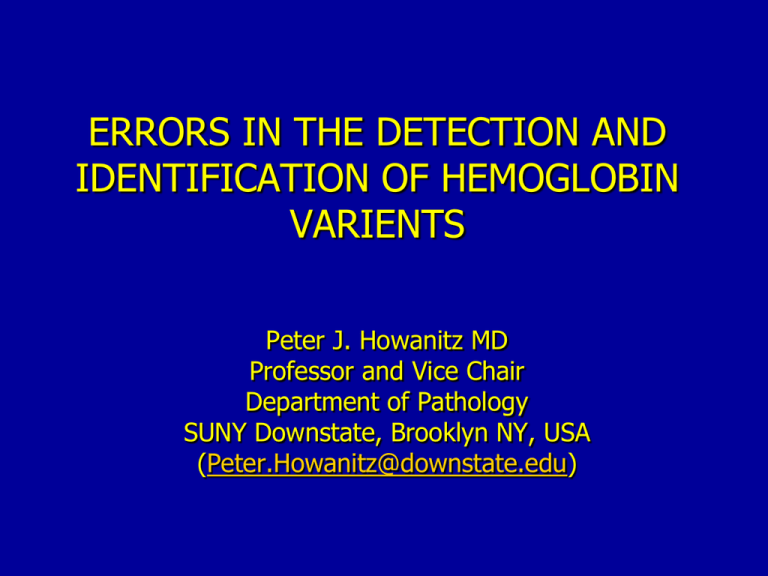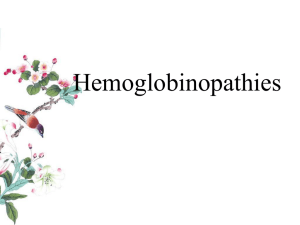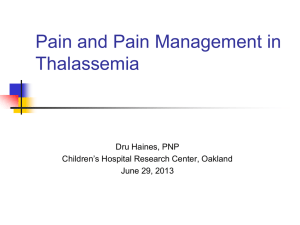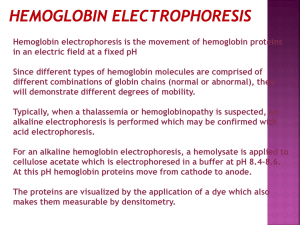G Georgia Jordan - IAP-AD
advertisement

ERRORS IN THE DETECTION AND IDENTIFICATION OF HEMOGLOBIN VARIENTS Peter J. Howanitz MD Professor and Vice Chair Department of Pathology SUNY Downstate, Brooklyn NY, USA (Peter.Howanitz@downstate.edu) GOALS AND OBJECTIVES • • • • • Describe Measurements Of Hemoglobins Introduce Role of HPLC Case Studies New Finding--Only A1C Detects Variant Questions And Answers REASONS FOR HEMOGLOBIN ID AND QUANTIFICATION • Newborn Screening • Prenatal Screening • Follow-up Newborn Screening • Diagnosis Cause of Microcytosis • Anemia, Polycythemia, Chronic Hemolysis • Hemoglobinopathy Blood Replacement • Unexplained A1c Results WHY USE HPLC? • Advantages – Throughput 11 Specimens/hour, 24 Hr Cal. – Analytic Sensitivity @ Low Concentrations – Improved Precision – Better Separation – Less Referrals For ID • Disadvantages – More Complex→ Higher Skill Level – Co-elution Of Hemoglobins Hemoglobin Electrophoresis Patterns STRUCTURE HEMOGLOBINS Hemoglobin A Globin Chain α2β2 A2 α2δ2 F α2γ2 Adult Level A >95% 2-3% F< 2.0% COMMON HEMOGLOBIN POINT MUTATIONS • Alpha Chain Variants – G Philadelphia (α68 Asn→Lys) – – – – S (β6 Glu→Val) C (β6 Glu→Lys) E (β26 Glu→Lys) D Los Angeles (β22 Glu→Gln) -- A2’ (δ16 Gly→Arg) • Beta Chain Variants • Delta Chain Variants INTERPRETATION OF HPLC RESULTS • • • • • • • • Hemoglobin Retention Time Variant Hemoglobin Percentage* A2 Percentage* Number of Variants* CBC Indices* Transfusion History Age Clinical Course* • * Changed By Thalassemia BIO-RAD VARIANT WINDOWS PEAK NAME RETENTION PEAK NAME TIME (MIN) RETENTION TIME (MIN) F Window 0.98-1.20 A2 Window 3.30-3.90 P2 Window 1.24-1.40 D Window 3.90-4.30 P3 Window 1.40-1.90 S Window 4.30-4.90 A0 Window 1.90-3.10 C Window 4.90-5.30 INTREPRATION OF RESULTS # Abnormal Peaks (%) A% A2% VARIANT EXAMPLE 1 (25-40) 50-60 3.5-4.5 β-Chain AS, AC 2 (25, 1.0) 70-80 1.5-2.2* α-Chain AG-Phil 2 (50,45) 0 3 40-50 (12, 20,14) 3.5-4.5 2.0* 2 β-Chain SC 1 α-,1 β-, ASG1αβPhilly Chain INTREPRATION OF RESULTS • Hemoglobin F – >2-80% Babies – 90-100% Homozygous Hereditary Persistence Fetal Hemoglobin,β0, δβ0-Thal – 15-40% Heterozygous HPFH – 10-25% SS, Hydroxyurea Treated – 3-10% Homozygous Hemoglobinopathies, Anemias, Leukemias, Malignancies, – < 5% β-Thal, Lepore INTREPRATION OF RESULTS • Hemoglobin A – Increased P2-? Diabetes (↑A1C>7%) – Increased P3-(>P2) Old Specimen – Inverse of Other Hemoglobins – Focus on Abnormal Hemoglobins HEMOGLOBIN A2’ • • • • • • Elutes in S Window Δ16 Gly→Arg Characteristic Low A2 Percentage (1.0-2.5%) Most Common In Blacks (2%) CBC Normal Little Consequence, Except β-Thal (add A2) INTREPRATION OF RESULTS • Hemoglobin A2 – Increased • 4.0-7.0% Β-Thalassemia, Sβ+ Thal • 3.5-4.5% Hb AS, AC, SC, SS, CC • 6.5-14.0% Hb Lepore • 25-30% Hb E – Decreased • 1.3-1.7% Iron Deficiency, Sideroblastic, Aplastic Anemias • 1.5-2.3% δ Chain Variant (A2’), α Chain Variant HEMOGLOBIN E • Found in SE Asia, β26Glu→Lys • Most Common Hemoglobinopathy Worldwide • Complicated by Iron Def, Thalassemia, A2 • Elution Trait (Hb AE) – Asymtomatic, No CBC Abnormalities • Disease (Hb EE) – – – – Mild Anemia, Target Cells, ↓RBC Survival ↓Osmotic Fragility +Beta Thal = Severe, As Homozygous β-Thal +Alpha Thal=↓Hb E HEMOGLOBIN D D Window On Bio-Rad Variant Β121Glu→Gln Found In India (D-Punjab/D-Los Angeles) Most Common D In U.S. Blacks (< 0.02%) Trait Asymtomatic, No Anemia, Normal CBC Disease Asymtomatic, No Anemia/ Hemolysis D Los-AngelesS = Symptoms of Sickle Cell Disease HEMOGLOBIN G PHILADELPHIA • Elutes In D-Window • α68Asn→Lys of Hb A and A2 • Heterozygote-CBC Normal – Most Common α Chain Variant In Blacks, Italians (25%), Chinese – Associated With α-Thal (30%, 45%G) • Association With S or C Common (Double Heterozygote) HEMOGLOBIN S S Trait (Hemoglobin AS) β6Glu→Val Common In Blacks; Other Populations Asymptomatic, Blood Sickles in Vitro Protective Against Malaria S Disease (Hemoglobin SS) Severe Symptoms, Sickling in Vivo Hydroxy Urea Treatment→Induces F Crises→Bone Pain, Hemolysis, Stroke, etc Similar Symptoms Other Double Heterozygotes (SC) HEMOGLOBIN C • Prevalent in West Africa, 3% U.S Blacks • Trait (Hb AC) β6Glu→Lys – No Symptoms or Anemia, – Hypochromia, Up to 40% Target Cells • Disease (Hb CC) – Mild Hemolytic Anemia, Spenomegly – Rod Shaped Crystals in RBCs – Normochromic, Normocytic Anemia, – 40-90% Target Cells MORE RARE VARIANTS? BIORAD TURBO A1C-CHROMATOGRAM BIO-RAD A1C-AS CHROMATOGRAM BIO-RAD A1C AC CHROMATOGRAM BIO-RAD UNKNOWN VARIANT A1C CHROMATOGRAM TYPE 1 BIO-RAD UNKNOWN VARIANT A1C CHROMATOGRAM TYPE 2 HEMOGLOBIN A1C CHROMATOGRAPHS CONTROL PATIENT 1 PATIENT 2 A1C HPLC results of a control specimen and the patients’ specimens. Note the variant eluting at 0.872 & 0.853 minutes in chromatograms of patient 1 and patient 2 depicted by an arrow. HEMOGLOBIN IDENTIFICATION CHROMATOGRAMS CONTROL PATIENT 1 PATIENT 2 Hemoglobin HPLC results of a control specimen and the patients’ specimens. A hemoglobin variant is not identified in either chromatogram. HEMOGLOBIN IDENTIFICATION CAPILLARY ELECTROPHORETOGRAMS CONTROL PATIENT 1 PATIENT 2 Capillary electrophoresis of a control specimen and the patients’ specimens. A hemoglobin variant is not identified in either electrophoretogram HEMOGLOBIN ELECTROPHORESIS ALKALINE GEL ACID GEL Hemoglobin electrophoresis on alkaline and acid gel. The patient’s specimen migrates as S on alkaline gel, and a split A band on acid gel, identified as an arrow. Electrophoresis of the specimen from the second patient was identical to the first (not shown).Controls for C, S, F and A are the top two specimens in either gel. GENETIC ANALYSIS OF VARIANT • DNA Sequence Analysis – Alpha-2 Substitution – Codon 95 CCG To CTG, Pro To Leu • Hemoglobin G-Georgia – Compatible With Other Lab Findings HEMOGLOBIN G-GEORGIA • Five Cases In Literature • Found In Blacks & Portuguese • Increased 02 Affinity, Decreased HemeHeme Interaction • No CBC Abnormalities • Double Heterozygote With S & C CONCLUSIONS • HPLC Valuable Laboratory Technique • Discussed Common Variants • Interpreted Chromatograms–Case Studies • New-Hemoglobin G-Georgia Not Noted • Important To ID A1c Variants • Questions?








